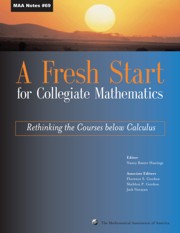Book contents
- Frontmatter
- Preface
- Contents
- Introduction
- Background
- Theme 1 New Visions for Introductory Collegiate Mathematics
- Theme 2 The Transition from High School to College
- Theme 3 The Needs of Other Disciplines
- Theme 4 Student Learning and Research
- Theme 5 Implementation
- Theme 6 Influencing the Mathematics Community
- Ideas and Projects that Work: Part 1
- Ideas and Projects that Work: Part 2
- 35 Mathematics in Action: Empowering Students with Introductory and Intermediate College Mathematics
- 36 Precalculus: Concepts in Context
- 37 Rethinking College Algebra
- 38 From The Bottom Up
- 39 The Functioning in the Real World Project
- 40 The Importance of a Story Line: Functions as Models of Change
- 41 Using a Guided-Inquiry Approach to Enhance Student Learning in Precalculus
- 42 Maricopa Mathematics
- 43 College Algebra/Quantitative Reasoning at the University of Massachusetts, Boston
- 44 Developmental Algebra: The First Mathematics Course for Many College Students
- 45 Workshop Precalculus: Functions, Data, and Models
- 46 Contemporary College Algebra
- 47 Precalculus: A Study of Functions and Their Applications,
- 48 Success and Failures of a Precalculus Reform Project
43 - College Algebra/Quantitative Reasoning at the University of Massachusetts, Boston
from Ideas and Projects that Work: Part 2
- Frontmatter
- Preface
- Contents
- Introduction
- Background
- Theme 1 New Visions for Introductory Collegiate Mathematics
- Theme 2 The Transition from High School to College
- Theme 3 The Needs of Other Disciplines
- Theme 4 Student Learning and Research
- Theme 5 Implementation
- Theme 6 Influencing the Mathematics Community
- Ideas and Projects that Work: Part 1
- Ideas and Projects that Work: Part 2
- 35 Mathematics in Action: Empowering Students with Introductory and Intermediate College Mathematics
- 36 Precalculus: Concepts in Context
- 37 Rethinking College Algebra
- 38 From The Bottom Up
- 39 The Functioning in the Real World Project
- 40 The Importance of a Story Line: Functions as Models of Change
- 41 Using a Guided-Inquiry Approach to Enhance Student Learning in Precalculus
- 42 Maricopa Mathematics
- 43 College Algebra/Quantitative Reasoning at the University of Massachusetts, Boston
- 44 Developmental Algebra: The First Mathematics Course for Many College Students
- 45 Workshop Precalculus: Functions, Data, and Models
- 46 Contemporary College Algebra
- 47 Precalculus: A Study of Functions and Their Applications,
- 48 Success and Failures of a Precalculus Reform Project
Summary
Motivation
For many years, the head of Continuing Education at the University of Massachusetts, Boston had been receiving complaints from industry that their employees couldn't think quantitatively. She called together a handful of faculty from the Mathematics Department, Graduate School of Education, and Academic Support, and asked us to a design a course she could market to these companies. Having an academic bias, we took this as an opportunity to revise our traditional college algebra course—with the thought that later some of the modules could be used to serve the corporate world.
The discontent (at least for some) with the college algebra course was for the usual reasons:
It was a fast forward version of a skill and drill high school course in which many of our students had fared poorly the first time around.
The students viewed the topics as irrelevant and boring.
College algebra had the largest enrollment in the Math Department, but only because it was the penalty foisted upon most students as a result of distribution requirements.
The failure/withdrawal rate was unacceptably high.
In an informal survey, less than 2% of the students in calculus came from college algebra.
Judy Clark and I received an NSF grant to rethink college algebra. The result is the text Explorations in College Algebra [1], which we now use in an alternative college algebra course called Quantitative Reasoning.
- Type
- Chapter
- Information
- A Fresh Start for Collegiate MathematicsRethinking the Courses below Calculus, pp. 364 - 368Publisher: Mathematical Association of AmericaPrint publication year: 2006



